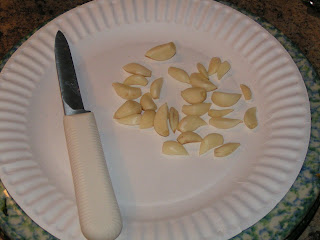Puerto Rican pork roast, that is!
Isn't that a thing of beauty? Look at that layer of lovely fat! Now that is going to be one moist, succulent roast!
I'm not sure what the recipe is really called, but I got it from my half PR sister-in-law and she got it from her PR grandmother, and that is what she called it when she told me how to make it. There were two versions she learned, one called for key lime juice and the other called for white vinegar. I switched it to raw apple cider vinegar, since I prefer it to the harshness of the distilled grain vinegar that is white vinegar. One day, after I bottle my current batch of onion wine, I'll make a gallon of onion wine vinegar to use in this recipe and others.
A recent study utilizing dark field microscopy indicated that uncured pork, even from properly raised pastured pigs, will cause a stickiness of the blood for many hours after eating it. This can create a dangerous situation for anyone with compromised health....and we all have compromised health nowadays! Since we will be eating a lot of pork in this household in the upcoming months, I will be exploring more ways of using vinegar marinades, which neutralize this bad effect on our cardiovascular system. Super-antioxidants will have the opposite effect, creating a healthy blood flow within minutes of ingesting them. Therefore it might be wise to have some OPC-3 with a meal of uncured or unmarinated pork. Or you might serve elderberry wine with it or elderberry pie for dessert.
Now the recipe: You will need a nice fatty pork roast. The cheaper cuts work the best, especially those with a nice layer of fat. I used a sirloin roast only because our hog freezer is so full and it was the first one I could pry out of the packed shelves that was the appropriate size.....without being buried in a pork avalanche. My recipe calls for a five pound roast, but you can use anything you have. Just adjust the recipe for the adobo accordingly, and the cooking time.
For the adobo (marinade) you will need fresh garlic, powdered oregano (you can powder any oregano you have with a mortar and pestle), salt and pepper, vinegar and olive oil.
I had garlic from my garden. Since the cloves were on the small side, I peeled more than twelve of them, but the recipe called for twelve cloves of garlic, crushed in the mortar and pestle. My sister-in-law tells me that a wooden one is traditional, and the garlic is less likely to try to escape while you are pounding it. I have a marble one, so I add something from the dry ingredients to help control the frisky garlic. Here I used the salt and pepper.
Next, add a tablespoon of powdered oregano. I had whole leaf oregano from the garden. It keeps its flavor best if stored as whole as possible, so I rubbed it down in my hands in batches before powdering it.
Next, add a couple tablespoons of extra virgin olive oil and a quarter cup of vinegar, mix well.
Cut slits in the roast on all sides....I mostly just poked it with a sharp knife. It was kinda fun, I admit. Then rub in some of the adobo, massaging well until the pork is relaxed and stress-free.
Either put the rest of the adobo on the roast, distributing it as evenly as possible and cover and refrigerate, or put it into a Ziploc freezer bag and refrigerate overnight. Turn the roast now and then and redistribute the adobo as necessary.
The next day, roast it uncovered at 350 F for 2-2.5 hours, basting occasionally. Just plop it in a pan:
Roast for the appropriate amount of time for the size roast you chose. I roasted this one for about 2.5 hours, then let it rest for a while while I finished the veggies (beets and green beans.) I basted twice....it wasn't really necessary with that thick layer of fat. If you have a store bought roast that is a bit lean, you will want to baste every 30-45 minutes or so.
It smelled so good that we dove into it before I remembered to take a picture:
I've been known to pick off the crust and eat it, bit by bit, when the roast comes out of the oven, it is that good. This is great with collards or other hearty greens on the side, and rice and beans if you like. It is wonderful in cold or hot sandwiches, too. I like a bit of homemade fermented mustard on mine and a slab of Caerphilly cheese. Sure, go ahead, have a multi-cultural lunch. Most of us are pretty multi-cultural ourselves....my family sure is!
What foods do you enjoy from lands near or far?









No comments:
Post a Comment